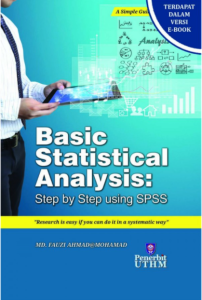BASIC STATISTICAL ANALYSIS: STEP BY STEP USING SPSS
Synopsis
The main objective of this book is to provide step by step guidance in statistical analysis. It starts from explanation on type of statistical analysis, steps, results, interpretation and reporting. This book will improve statistical analysis understanding amongst students and researchers. This book contains twelve chapters. In each chapter, examples of the statistical analysis are provided for better understanding using SPSS. Furthermore, the interpretations of statistical result are explained in details for each of the examples. Hopefully this book will provide useful reference towards a better understanding in statistical analysis which shall lead to implementing successful research for students and researchers.
Downloads
References
Awang, Z. (2012). A Handbook on SEM (5th ed.). Kota Bharu: UITM.
Brown, R. L. (1994). Efficacy of the indirect approach for estimating structural equation models with missing data: A comparison of five methods. Structural Equation Modelling, 1(4), 287–316.
Byrne, B. . (2010). Structural Equation Modeling with AMOS. Structural Equation Modeling (2nd ed.). New York: Routledge Francis & Taylor.
Chi, A., Bahjat, A., & Matsui, Y. (2011). Quality management practices and competitive performance : Empirical
evidence from Japanese manufacturing companies. Intern. Journal of Production Economics, 133(2), 518–529. doi:10.1016/j.ijpe.2011.01.024
Chinna, K. (2009). Structural Equation Modeling Using AMOS (p.20). Kuala Lumpur: Malaysia: Lecture Note for SPSS User’ Group.
Demirbag, M., Tatoglu, E., Tekinkus, M., & Zaim, S. (2006). An analysis of the relationship between TQM implementation and organizational performance: Evidence from Turkish SMEs. Journal of Manufacturing Technology Management, 17(6), 829–847. doi:10.1108/17410380610678828
Field, A. (2009). Discovering Statistics Using SPSS. Statistics (2nd ed.). London: Sage Publication.
Galbreath, J. (2005). Which resources matter the most to firm success? An exploratory study of resource-based
theory. Technovation, 25(9), 979–987. doi:10.1016/j. technovation.2004.02.008
Graham, J. W., Hofer, S. M., Donaldson, S. L., MacKinnon, D. P., & Schafer, J. L. (1997). The Science of Prevention:
Methodological advances from alcohol and substance abuse research (pp. 325–366). Washington, DC: American Psychological Association.
Gunday, G., Ulusoy, G., Kilic, K., & Alpkan, L. (2011). Effects of innovation types on firm performance. International Journal of Production Economics, 133(2), 662–676. doi:10.1016/j.ijpe.2011.05.014
Hair, J. F. (2010). Multivariate Data Analysis. New York: Pearson Prentice Hall.
Jaykaran (2010). How to select appropriate statistical test?. Journal of pharmaceutical Negative Results, Oct (2), 61-63.
Kline, R. . (2011). Principles and practices of structural equation modeling (3rd ed.). New York: The Guilford Press.
Krejcie, R. V., & Morgan, D. W. (1970). Determining sample size for research activities. Educ Psychol Meas.
Nunally, J. C. (1978). Psychometric Theory (Second ed.). New York: McGRAW-HILL.
Nunnally, J. C., & Bernstein, I. H. (1994). Psychometric Theory (3rd editio.). New York: McGRAW-HILL.
Rohani, J. M., Yusof, S. M., & Mohamad, I. (2009). The relationship between statistical process control critical success factors and performance: A structural equation modeling approach. 2009 IEEE International Conference on Industrial Engineering and Engineering Management, 1352–1356. doi:10.1109/IEEM.2009.5373033
Sekaran, U. (2003). Research methods for business: a skill building approach. Hoboken, NJ: John Wiley & Sons.
Sekaran, U., & Bougie, R. (2010). Research methods for business: a skill building approach. UK: Wiley.




